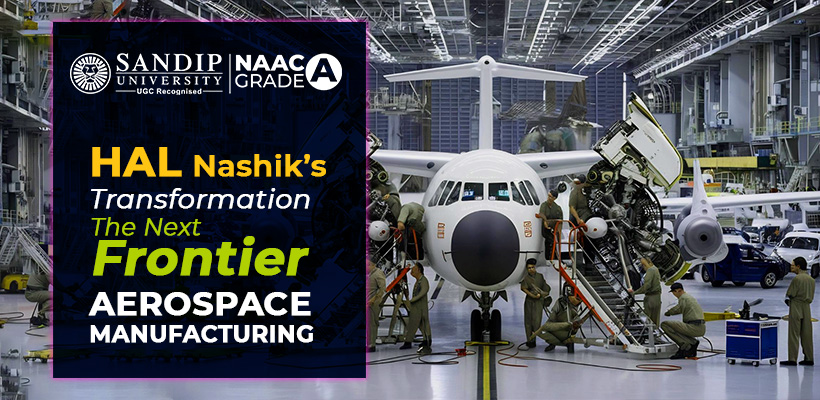As per the latest developments, reports suggest that Russia may offer joint production of the SU-57 stealth fighter jet to Hindustan Aeronautics Limited, Nashik. They are providing India with advanced tech transfer, joint production, and full production rights. It indicates that SU-57 will not only be made in India, but it also has the right to sell them in defence deals to different nations.
This collaboration is a groundbreaking opportunity for aspirants planning to pursue an aerospace engineering program. With such degrees, you have the chance to contribute to the making of 5th Gen Fighter Jets. With such possibilities, Nashik has massive potential. Let’s explore how Nashik can grow into an advanced aerospace hub and what it means for the students.
What Does this Mean for Students Pursuing an Aerospace Engineering Degree?
Multiple Choices for Career Roles –
As a certified professional, you have the opportunity to work in the structural design sector, such as stealth shaping and airframe. Along with this, material science that is composites and coatings, avionics and electronics, software, light control, and mission computers, integration of the system, and
Hands-On Experience –
Internships are crucial for aerospace engineering students because they need hands-on practice to polish their skills. B.Tech Aerospace engineering students from Sandip University will have the opportunity to work on live projects, validation testing, and building prototypes. There are numerous teams dedicated to carrying out different kinds of work. Therefore, you may get an internship chance to be a part of one such team examining radar reflections, simulating flight behaviour, or testing stealth coatings.
Learning About the Cutting-Edge Technology –
As the technology is upgrading, students will be educated about the stealth technologies that are essential for 5th Gen fighter jet manufacturing. You will learn about AI used for mission systems, AESA radars, signal processing, advanced simulation tools, and advanced manufacturing, such as additive manufacturing or robotics.
Promising Career Prospect –
The demand for advanced aerospace skills is on the rise, and it will continue to increase in Nashik and other HAL units. The demand will also increase in other manufacturing units, such as private defence firms and research and development laboratories. Students will also have the opportunity to work with global partners that are located nationally and internationally.
Making Patriotic and Strategic Contributions –
Aerospace engineering students will not only make a promising career in aerospace manufacturing, but you have the chance to contribute to the country’s defence capabilities by making it independent or self-reliant. It is deeply satisfying to be a part of the project that is for strengthening India’s sovereignty.
Hal Nashik: Its Current Strength
Before imagining the future of HAL, it is necessary to determine its present strength and what it is good at:
Aircraft –
- A light combat aircraft – LCA Tejas Mk1A
- Advanced fighter jet, listed among the current manufacturing programs – SU-30 MKI
- A transport aircraft – Dornier 228 / Hindustan
- HAL manufactures accessories for the trainer aircraft – Hawk
- A basic trainer aircraft – HTT 40
Helicopters –
- A weapon system integrated version of Dhruv – Rudra
- The advanced light helicopter – ALH Dhruv
- Other helicopter models – Chetak and Cheetal
- The light combat helicopter – LCH
- The light utility helicopter – LUH
- 5+ generation medium-weight fighter (Under development) – HAL Tejas MK2
Components and Systems –
- Engines
- Avionics and accessories
- Space components
Other Activities –
- Their additional activities include maintenance, repair, and overhaul (MRO), along with the servicing of the aircraft, power plants, helicopters, and systems.
- They are also supplying the spare parts for the military aircraft.
What Opportunities can it bring To India with the Manufacturing of the SU-57?
- Transfer of the technology
- Upgrades in the manufacturing standards
- Expansion of supply chains and localisation
- Better skills and an increase in employment
- Exposure to certification, R&D, and testing
- Global recognition and collaboration
Challenges in the Process of manufacturing SU-57 in Nashik HAL:
In the process of HAL becoming more advanced in terms of manufacturing 5th Gen fighter jets, there are significant challenges and roadblocks, but a brighter future by bridging the gap. Some of them include sensitive technologies and maintaining secrecy, lack of appropriate skills, delay in supply chains, overrunning of budget, regulatory and certification hurdles.
If Russia’s offer becomes real, HAL Nashik has a remarkable chance to become a major hub for manufacturing 5th Gen fighter jets. Aerospace engineering students will be a part of building fifth-generation fighter jets, and contributing to making India self-reliant in aerospace and defence.
Aerospace Engineering Students May Focus On:
- Aerodynamics, materials, electronics, and software
- Hands‑on skills: labs, workshops, internships
- Knowledge on quality, testing, and safety standards
- Keeping abreast of new technologies: stealth, AI, avionics, composites
Someday, Nashik will need young engineers like you to be a part of building the next generation of stealth fighter jets. And that could shape not only your future, but India’s aerospace journey too.

